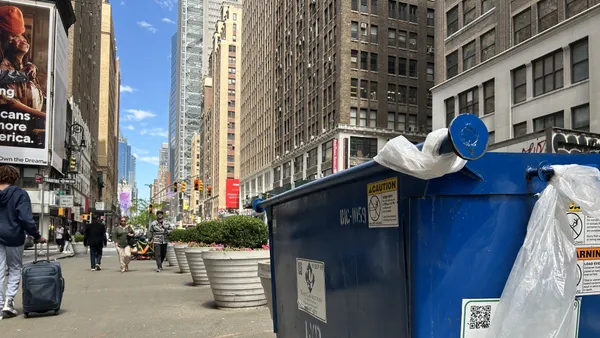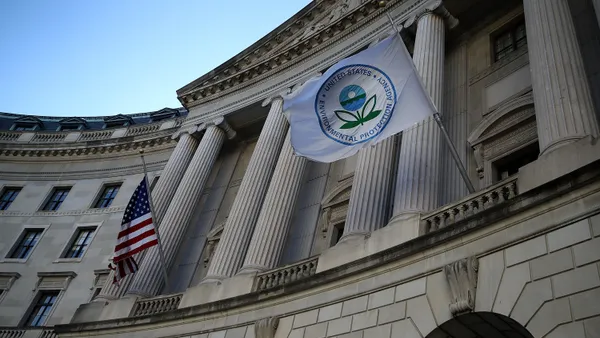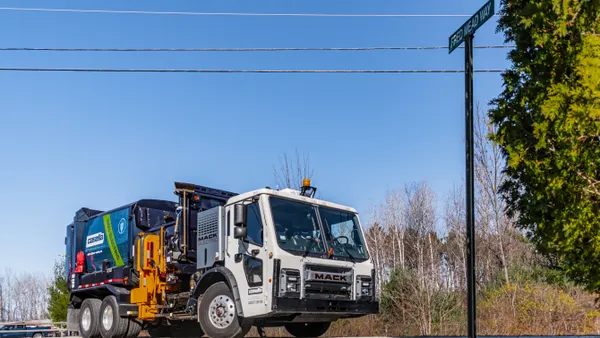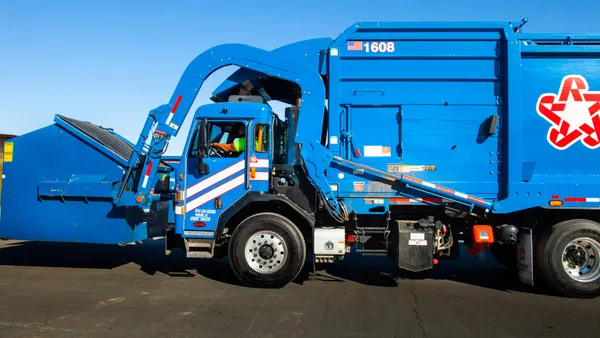It's sometimes easy to lose sight of just how enormous the waste and recycling industry is — and where some of its biggest names fit into the picture. Each quarter, companies provide a wealth of financial information and talk to analysts about various business trends — but some of the most comprehensive information comes from their annual 10-K reports.
Since earnings reports wrapped up for Q4/full-year 2018, Waste Dive has been sifting through those 10-Ks for useful details to help contextualize some key industry discussions.
All data is current as of Dec. 31, 2018. Covanta has been excluded to allow for more direct comparisons among the five vertically-integrated public companies.
1. Across the Map:
The publicly-traded companies can often feel omnipresent — so just how widespread are their operations?
- Waste Management — 49 states (all but Montana) and the District of Columbia, plus multiple Canadian provinces
- Republic Services — 41 states, the District of Columbia and Puerto Rico
- Waste Connections — 41 states and six Canadian provinces
- Advanced Disposal Services — 16 states and the Bahamas
- Casella Waste Systems — 6 states
2. Big and Getting Bigger:
The pace of industry consolidation has increased following the 2017 corporate tax cut and various other factors. Some of 2018's biggest deals were done on the private side, but the five publicly-traded companies were also active with tuck-ins and mid-size acquisitions.
Here's how many companies each respectively subsumed in 2018:
- Waste Management - 32
- Republic Services – Not specified
- Waste Connections – 20
- Advanced Disposal Services – 12
- Casella Waste Systems – 10
3. Unionized Workforce:
The five publicly-traded service providers reported employing approximately 104,430 people full-time at the end of 2018, including a small portion in Canada. An estimated 20% of the publicly-traded company workforce is covered by collective bargaining agreements, compared to a private sector average of 6.4% for the U.S. in 2018 and 15.2% for Canada as of 2014. Here's the breakdown:
- Waste Management (U.S. & Canada) – Approx. 43,700 employees, 19% union
- Republic Services – Approx. 36,000 employees, 24% union
- Waste Connections (U.S. & Canada) – 16,356 employees, 18.9% union
- Advanced Disposal Services – 6,074 employees, 14% union
- Casella Waste Systems – 2,300 employees, 4.4% union
4. MRF Footprint:
The same handful of companies often command the bulk of recycling coverage — but how much recycling infrastructure do they actually manage?
Details vary in terms of full ownership versus operating contracts, but for the purposes of establishing presence, it's fair to say all five publicly traded companies combined are in 297 MRFs across North America. The U.S. alone has 497 MRFs, according to data from Governmental Advisory Associates. This includes a small number of mixed waste facilities, which aren't differentiated in annual reports. Here's the breakdown, combining ownership and operation contracts:
- Waste Management — 102
- Republic Services — 91
- Waste Connections — 64
- Advanced Disposal Services — 22
- Casella Waste Systems — 18
5. Landfill Footprint
The Environmental Research & Education Foundation estimates there are approximately 1,500 active MSW landfills in the U.S. Data for Canada is less readily available, but previous estimates have put the total number of landfills as high as 2,000. The vast majority of these sites are small, local operations. Overall, the five publicly-traded companies report running 542 active landfills across North America.
Here's the breakdown of active sites, combining ownership and operation contracts:
- Waste Management — 247 solid waste landfills, 5 hazardous waste
- Republic Services — 190 solid waste landfills
- Waste Connections — 56 solid waste landfills, 14 non-MSW (C&D etc), 11 E&P landfills
- Advanced Disposal Services — 41 solid waste landfills
- Casella Waste Systems — 8 solid waste landfills, 1 C&D
6. Landfill Capacity
Landfill capacity estimates remain fluid — it's likely that changes have already occurred since this data was finalized on Dec. 31, 2018 — but it's safe to say that every company is confident it will have room to bury for decades to come. Here's how each company describes its position:
- Waste Management — "Although no assurances can be made that all future expansions will be permitted or permitted as designed, the weighted average remaining landfill life for all owned or operated landfills is approximately 43 years when considering remaining permitted airspace, expansion airspace and projected annual disposal volume."
- Republic Services — "The average estimated remaining life of all of our landfills is 63 years. We have other expansion opportunities that are not included in our total available airspace because they do not meet all of our criteria for treatment as probable expansion airspace."
- Waste Connections — "Owned landfills and landfills operated under life-of-site agreements have estimated remaining lives, based on remaining permitted capacity, probable expansion capacity and projected annual disposal volumes, that range from approximately 1 to 157 years, with an average remaining life of approximately 29 years."
- Advanced Disposal Services — "Our active landfills that are currently accepting waste have an average of 36.8 years of aggregate remaining permitted and deemed permitted life ... To satisfy future disposal demand, we are currently seeking to expand permitted capacity at 15 of our landfills and we may seek expanded permitted capacity at other landfills in the future."
- Casella Waste Systems did not specify its estimated remaining capacity in years.
7. Landfill Lifespan
The industry has recognized the growing difficulty of expanding existing landfills or building new ones — and considering the high costs of post-closure care, maximizing site life is increasingly critical.
Here's the breakdown of active estimated site life based on operating lives, remaining permitted and expansion capacity and projected annual disposal volume — all of which are, of course, subject to change:
| 0-5 Yrs | 6-10 Yrs | 11-20 Yrs | 21-40 Yrs | 41+ Yrs | |
| Waste Management | 11.9% | 6.4% | 13.9% | 27% | 40.9% |
| Republic Services | 6.3% | 9.5% | 16.3% | 28.9% | 39% |
| Waste Connections | 4.9% | 7.4% | 23.5% | 32.1% | 32.1% |
- Republic Services — Republic is the only company to offer a breakdown by probable airspace expansion. Which this is limited on a quantity basis, the company still has significant years remaining overall.
- Waste Connections is the only company to include a 51+ year category, which includes 17 sites. It also breaks down details for eight additional landfills operated under life-of-site agreements, all but one of which has at least 21 years remaining.
- Advanced Disposal Services and Casella Waste Systems do not provide lifespan breakdowns.
8. Environmental Risks
Climate change doesn't come up very often (if at all) during earnings calls, but it has been a regular feature in many company 10-Ks dating back multiple years. Each company recognizes as a pending factor the potential for state and federal regulations to crack down on greenhouse gas emissions from their operations — and some even specify how certain carbon reduction service offerings could represent a business opportunity.
On a purely numerical basis, here's how many times "climate change" appears in each company's report:
- Waste Management — 9
- Republic Services — 10
- Waste Connections — 7
- Advanced Disposal Services — 6
- Casella Waste Systems — 0
9. LFG
Given that landfill emissions remain one of the industry's biggest regulatory liabilities, many companies have pursued landfill gas-to-energy projects as a way of demonstrating compliance and generating additional revenue. Some companies (due, in many cases, to the unique qualities of their respective sites) are farther along than others:
- Waste Management — 130 "landfill gas beneficial use projects." These includes 101 that create electricity and 19 that either create pipeline quality natural gas for sale to the grid, purchase from industrial customers or direct on-site use.
- Republic Services — 75 "landfill gas-to-energy and renewable energy projects"
- Waste Connections — 52 "gas recovery systems"
- Advanced Disposal Services — 17
- Casella Waste Systems — 4
10. Evolving Priorities
The risk and regulation sections of each report remain fairly static each, with a few exceptions. In 2018, however, some of the biggest companies included a few notable changes:
- Waste Management added a section on the Renewable Fuel Standard (due in part to its increasing share of natural gas vehicles) and appears confident in the pricing trajectory for renewable identification number (RIN) credits: "Based on the overall political framework and the upcoming [EPA] rulemakings, we anticipate a stable market for the Company’s RINs."
- Waste Management also added a section on plastic waste (and is currently the only company to do so), citing "a heightened awareness of the global problems of plastic waste in the environment," single-use plastic bans in more than 350 cities and California's 2016 plastic bag ban. The company is facing a push from manufacturers "to accept a broader array of materials in curbside recycling programs to alleviate public pressure to ban the sale of those materials" but concludes that "there are currently no viable end markets for recycling these materials."
- Both Waste Management and Republic Services highlighted growing regulatory attention around PFAS, each citing the potential for additional expenses as a result of complying with evolving state and federal regulations.












